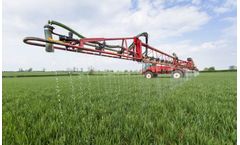Crop Nitrogen Articles & Analysis
18 news found
This year’s challenge takes place on the Yorkshire Wolds with each entrant being assigned a 48 m2 plot of winter wheat replicated 4 times. A separate control treatment will receive nutrition in line with RB209 field assessment recommendations and a second control treatment will be left untreated. Other than fertiliser and biostimulant choice and timings, all other crop applications will ...
Ginkgo Bioworks becomes a multi-year strategic partner with Bayer to develop biological solutions in areas such as nitrogen optimization, carbon sequestration, and next generation crop protection Open Innovation Sourcing is expected to accelerate Biologicals R&D pipeline by tapping into the worldwide open innovation ecosystem Bayer to continue work to ...
ByBayer AG
Unlike synthetic nitrogen, Pivot Bio’s microbes give growers confidence that this source of nitrogen reaches the crop. When growers use synthetic nitrogen, they must overapply to compensate for the 40-60% that never reaches the crop. ...
Sulphur is a key component when growing high yielding, healthy crops. Whilst Nitrogen is a growth promoter, Sulphur works as a growth regulator, effectively balancing the manufacture of sugars and proteins in leaf tissue with the demand from these materials throughout the plant. ...
Their advice: chose a mixture of winter cover crops which is productive and high in nitrogen, avoid the succession of closely related crops. Biomass and nitrogen concentration, those are the keywords for a successful application of winter cover crop mixtures. ...
” Agritech Expo Zambia workshops programme: Commercial Farmers Focus Day workshops, Thursday, 27 April Theme: Advancing commercial farming through financial support and innovation Topics: - Integrated, low risk crop protection solutions - Cash flow based solutions - Breakthrough microbial formulations - Key fundamentals of finance and farm management Interactive training ...
Farmers’ and growers’ confidence in digestate and compost has been given a welcome boost, as new ground-breaking research published today, shows smart use of these renewable fertilisers can increase yields and reduce bills with no negative impact on crop quality or safety. The programme of field experiments, ‘Digestate & Compost in ...
Fortunately, many farmers are already doing their part to improve water. For example, cover crops can keep phosphorus, nitrogen and other nutrients from escaping fields and entering waterways. ...
Growers considering adding nitrogen to chickpeas to boost yield should save their money, according to the results of recent trial research. Trials by the Northern Grower Alliance and funded by the Grains Research and Development Corporation found that adding nitrogen to crops did not have any impact on yield, making the additional cost and ...
A recent focus on both the positive and negative effects of nitrogen applications has researchers across the globe working to find methods that can increase crops' "nitrogen use efficiency" (NUE) to contribute to more sustainable, responsible agricultural practices. ...
For many the summer cropping rotation will include sorghum and maximising crop yield and profitability will be a key driver of all pre-plant and in-crop agronomic decisions. Recent research funded by the GRDC, Queensland Alliance for Agriculture and Food Innovation (QAFFI), Department of Agriculture, Fisheries and Forestry Queensland (DAFF) and ...
Nitrogen and phosphate are important fertilisers. But excessive amounts often found in fields and pastures end up polluting the ground and surface water. ...
Such cover crops can contribute substantial amounts of nitrogen to subsequent crops, as well protect soils from erosion and promote overall soil quality. Legumes tend to release nitrogen more slowly than synthetic fertilizers, possibly being more synchronous with crop demand. That does not mean that ...
Nitrogen fertilizer is a key ingredient for growing a good corn crop. It is not unusual for a well-fertilized crop to yield more than twice as much as an unfertilized crop. But how much nitrogen should corn producers apply to their crop? Researchers at the University of Missouri help answer this ...
From 1998 to 2008, the researchers evaluated and compared potential management strategies for reducing nitrogen and nitrate nitrogen levels in soil and groundwater. The research, led by ARS soil scientist Ardell Halvorson, focused on irrigated cropping systems in the Arkansas River Valley, an agricultural region of Colorado that has high levels ...
New research reveals that rice can be modified to use nitrogen more efficiently, thus reducing the need for nitrogen fertilisers while increasing yields. ...
Combating soil erosion is a primary concern for agricultural producers in the United States, and many have incorporated conservation tillage systems in their effort to maintain a profitable crop output. Cover crops are an important tool in this cycle, and while it is known that using nitrogen fertilizers can increase these crops ...
Soybean showed a smaller reduction of 1.4 per cent. Nitrogen fixing bacteria help ensure that legumes have access to sufficient nitrogen. ...















